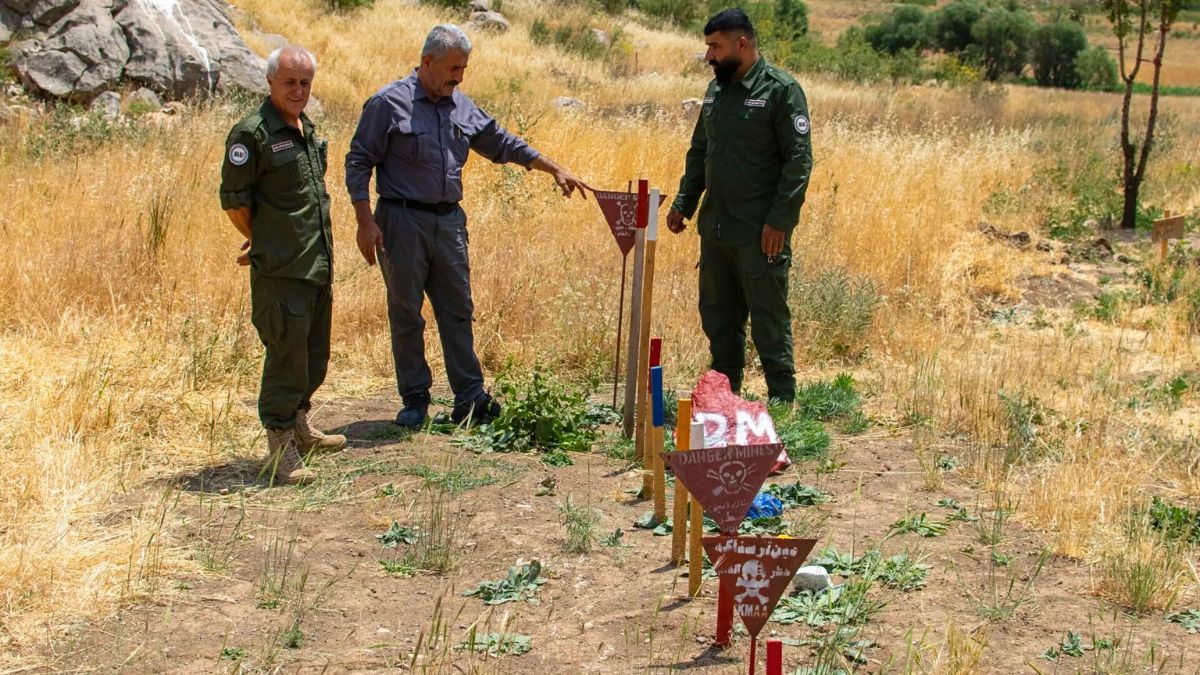Driving deep into the mountainous Choman district in Iraq’s Kurdistan Region, expert deminer Smko Ahmed surveys patches of land that once hid deadly landmines. Years of work cleared these fields, allowing families to plant almond and apple trees, build homes, and farm tomatoes. Now, that progress is at risk.
The U.S.—long the world’s leading funder of humanitarian mine clearance—has pulled the plug on critical funding under the Trump administration. The result? Entire demining programs in Iraq have ground to a halt, staff have been laid off, and contaminated communities are again facing lethal threats.
Shutdown
The sudden cut in aid stems from a broader White House review of foreign aid spending by USAID and the State Department. As a result, organizations like Fondation Suisse de Déminage (FSD) were hit with stop-work orders. FSD, a Geneva-based nonprofit, had been working in post-ISIS territories where improvised explosive devices (IEDs) make farming and development nearly impossible.
Ahmed, who worked as FSD’s national operations manager, oversaw teams clearing up to 100 square meters of land daily. Then, everything stopped. Layoffs followed. “It was terrible,” Ahmed said. “Now, I don’t have any work. What do I do?”
Scope
Iraq is one of the world’s most heavily contaminated countries when it comes to landmines and unexploded ordnance (UXO). This includes legacy mines from the 1980s Iran-Iraq war, cluster bombs from the Gulf War, and IEDs from the Islamic State (ISIS) era.
As of 2023, more than 1,840 square kilometers—roughly the size of Buckinghamshire in the UK—remain contaminated. Despite the massive scale of the problem, only about 95 square kilometers have been cleared over the last five years.
In 2023 alone, Iraq saw the removal of 16,756 antipersonnel landmines. But with U.S. aid gone, that progress is in jeopardy.
Impact
The U.S. contributed $40.5 million to Iraq’s demining efforts in 2023—around 60% of all international aid for this purpose. Other contributors like Canada, Norway, France, and Germany pitched in, but at much lower levels.
Meanwhile, Iraq’s own federal government only allocated $3.9 million in 2022. The Kurdistan Regional Government (KRG) adds around $10 million annually, which keeps a few programs running but can’t match the scale of past efforts.
These cuts have a human cost. At least 39 people were killed and 63 injured by mines and explosive remnants in 2023. Without organized clearance, those numbers are expected to rise.
Livelihoods
The aid freeze didn’t just pause operations—it destroyed livelihoods. Hundreds of trained deminers, many from the same communities they were helping, lost their jobs. A demining tech in Iraq can earn $1,000 per month—a solid income for families trying to rebuild.
But now, families are losing both income and safety. Peter Smethers, FSD’s Iraq director, fears locals may try to clear mines themselves. “They need the land to live,” he said, but “disarming these devices is dangerous, even for professionals.”
Legislation
Back in Washington, efforts are underway to undo the damage. Representative Stephen Lynch (D-MA) introduced the Global Demining Protection Act in February to restore U.S. support for mine action. It aims to reestablish funding for programs that help stabilize conflict zones and return land to productive use.
However, the bill is stalled in committee, and its future is uncertain. Meanwhile, organizations like FSD scramble for alternative funding, but options are limited.
Future
The outlook is bleak unless the U.S. reverses course. Lieutenant Colonel Bakhtiar Mohammed of the Peshmerga Ministry believes reinstating funding would offer Iraqis a path toward normalcy. “They will have a normal life,” he said. “There will be a sense of safety and security.”
Until then, Iraq remains trapped—unable to heal from decades of war, blocked not just by mines, but by the lack of global support.
Here’s a quick snapshot of Iraq’s mine situation:
| Metric | Data (as of 2023) |
|---|---|
| Contaminated Land | 1,841.48 sq km (710 sq mi) |
| Cleared Land (2019–2023) | 94.81 sq km |
| U.S. Aid to Iraq Demining (2023) | $40.5 million (60% of global total) |
| Civilian Casualties (2023) | 39 killed, 63 injured |
| Federal Iraqi Contribution | $3.9 million (2022) |
| KRG Contribution | $10 million/year |
FAQs
Why did Iraq’s demining operations stop?
Because of U.S. foreign aid cuts under the Trump administration.
How much land is still contaminated in Iraq?
About 1,841.48 square kilometers as of 2023.
What impact did the cuts have on workers?
Hundreds of deminers lost jobs and income.
What is the Global Demining Protection Act?
A bill to restore U.S. funding for mine action programs.
Is local funding enough for clearance?
No, it’s insufficient to cover the scale of contamination.












